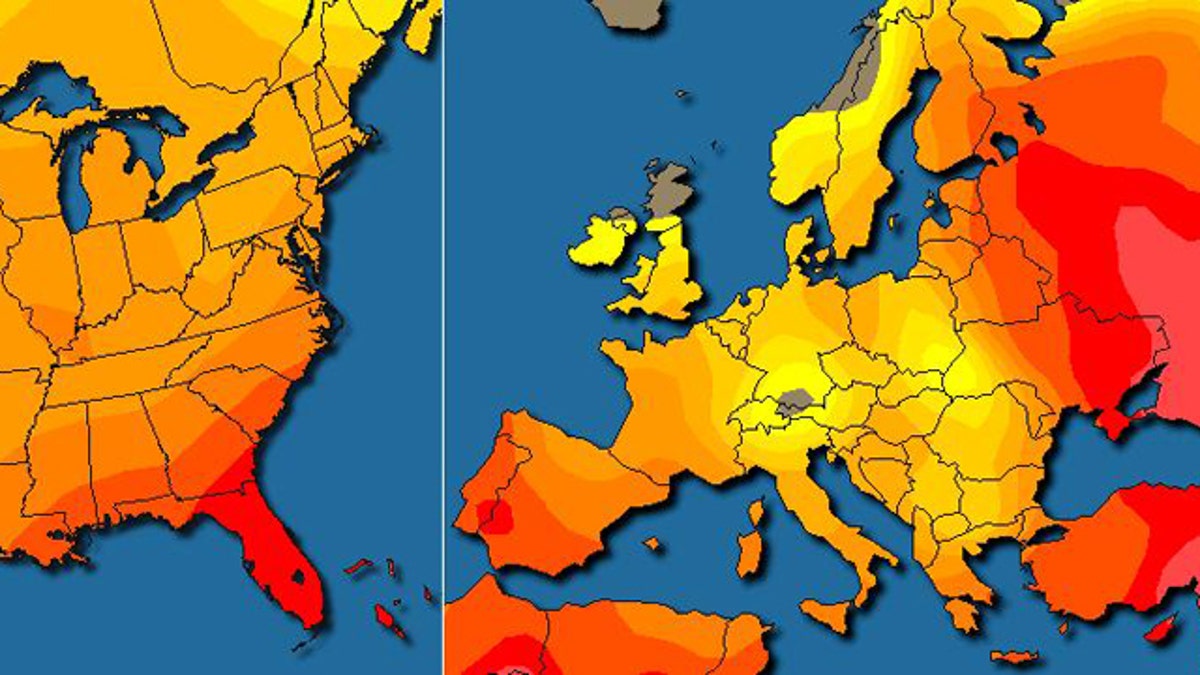
Charts showing the heat index indicate extreme temperatures across the globe, from the East Coast of the United States to Africa and Asia. (Wunderground)
It's hot. Really, really hot. Temperatures hit triple digits all over the country this month, which could turn out to be the hottest July ever. So . . . what's causing the heat?
June was the warmest month ever around the world, with temperatures averaging 1.22 degrees Fahrenheit above average, according to the National Oceanic and Atmospheric Administration's National Climatic Data Center, which has been keeping such records since 1880.
It also was the fourth-consecutive warmest month on record, leading to the question: Can we make it five in a row?
"Maybe, but only slightly," says Joe Bastardi, Accuweather's long-range forecaster, who has been a critic of how NOAA compares temperature data and says we can accurately compare global temperatures recorded by satellites only from 1978 to the present.
"I think we're sort of peaking now because of a natural cycle," says Bastardi, who predicts that La Nina -- a weather condition that describes cooler than normal sea surface temperatures in the Pacific -- will cause temperatures to drop for the rest of the year.
NOAA, on the other hand, predicts the trend will continue upward because greenhouse gases such as carbon dioxide are boosting overall temperatures. NOAA predicts July will break another record, despite La Nina -- and that 2010 will end up being the warmest year on record.
Head of NASA's Goddard Institute for Space Studies and leading government climatologist James Hansen writes that "global temperature continued to rise rapidly in the past decade, despite large year-to-year fluctuations associated with the El Nino-La Nina cycle of tropical ocean temperature."
Meanwhile, as scientists argue over what's causing the heat wave, the rest of us continue to sweat.
This summer has been a scorcher in three states -- Delaware, New Jersey and North Carolina -- where records were set for the hottest June ever. But for the country on the whole, last month was only the eighth warmest June on record. And it hasn't been hot everywhere: According to NOAA, it was cooler than average in several parts of the globe, including Scandinavia, southern China and the northwestern United States.
But in the Northeast the heat wave continues, with temperatures predicted to be in the 90s later this week in places like Washington, D.C., which already endured 18 straight days of 90-plus temperatures last month.
Even Antarctica is seeing warm weather. Although Amundsen-Scott Station at the South Pole reported a freezing -86 degrees early Tuesday, coastal parts of the icy continent were in the low 30s.
Still, it could be worse. The hottest place on the planet last month was Abdaly, Kuwait, where the mercury hit 126.7 degrees on June 15. Now, that's hot.
Follow John R. Quain on Twitter @jqontech or find more scitech coverage at J-Q.com.




















